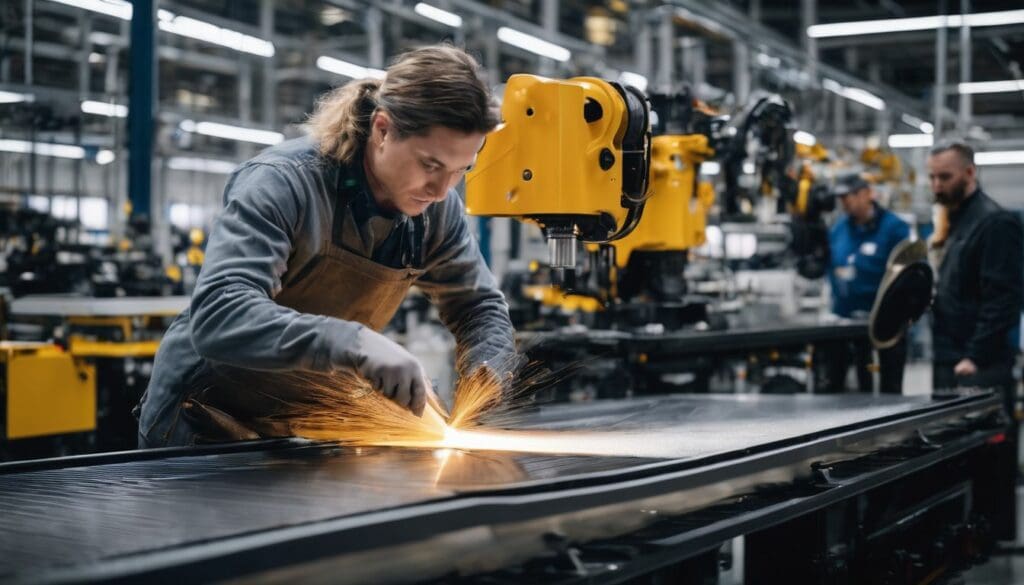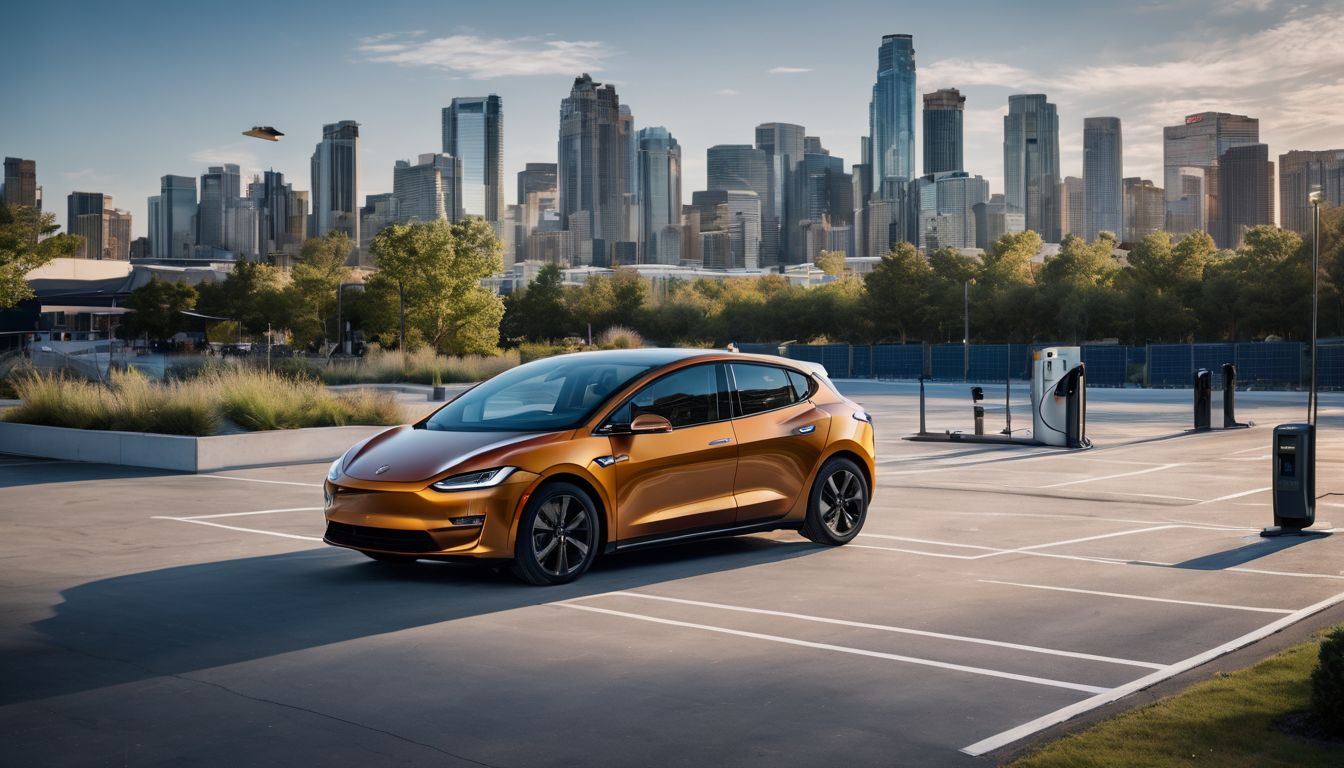Embarking on a quest to lessen the environmental impact of car production can seem rather daunting, can’t it? Rest assured, you’re not alone; we’ve encountered these very obstacles and have devoted time to comprehensively understanding how 3D printing is transforming the automotive sector.
Our explorations have uncovered that this innovative technology doesn’t just accelerate design and manufacturing processes – it also holds substantial eco-friendly promise by curtailing waste.
Join us as we explore together how adopting such advancements could steer us towards a more sustainable motoring future.
Key Takeaways
- 3D printing allows for rapid prototyping in the automotive industry, which speeds up development and reduces material waste. It lets designers test ideas quickly by producing prototypes on the same day.
- The technology aids in lightweighting car parts, improving fuel efficiency and performance, while also offering customisation of components such as seats and lug nuts, providing both comfort and security enhancements.
- Additive manufacturing with 3D printing is revolutionising production methods by creating intricate moulds and dies efficiently, supplying tailor-made manufacturing aids like jigs and gauges that streamline assembly lines.
- Classic car enthusiasts benefit from 3D printing because it produces hard-to-find spare parts accurately, helping to preserve vintage vehicles sustainably without the need for large-scale manufacture of new components.
- As advancements continue in 3D printing technology within the automotive sector, there is potential for mass production that respects environmental standards through efficient material use, possibly fostering a more sustainable future in vehicle manufacturing.
Benefits of 3D Printing in Automotive Design and Prototyping
3D printing in automotive design and prototyping offers the advantage of same-day prototyping, allowing for faster iteration and development of car parts. It also enables lightweighting car parts to improve fuel efficiency and performance.
Same-day prototyping
We understand the pace of innovation in the automotive industry, and with 3D printing technology, we can turn ideas into tangible prototypes within hours. This rapid prototyping not only speeds up the design process but also allows us to test and refine our concepts quickly without wasting resources.
Same-day prototyping is a game-changer for us as it aligns perfectly with our commitment to environmental conservation by minimising material waste.
By using additive manufacturing techniques, we produce only what’s necessary, slashing the carbon footprint associated with traditional manufacturing methods. Our team thrives on this efficiency; iterating designs faster contributes significantly to reducing energy consumption during production phases.
Harnessing this approach gives life to lightweight car parts that are next in line for revolutionising automotive engineering and design innovation.
Lightweighting car parts
Continuing our discussion on the benefits of 3D printing in automotive design and prototyping, the process also allows for lightweighting car parts. This technique involves creating complex geometries that reduce the weight of components without compromising strength or durability, contributing to improved fuel efficiency and reduced environmental impact.
By utilising advanced materials and innovative designs, 3D printing enables automakers to manufacture lighter yet robust parts, aligning with the sustainability goals of environmentally conscious individuals who value conservation efforts.
Moreover, this approach not only lessens the overall weight of vehicles but also enhances their performance while reducing material waste during production processes. The use of additive manufacturing in automotive manufacturing technology presents an exciting opportunity to advance towards more sustainable vehicle production by actively reducing carbon emissions and promoting eco-friendly operations within the industry.
Bringing concept cars to life
3D printing technology plays a pivotal role in breathing life into concept cars, allowing automotive designers to quickly transform their ideas into tangible prototypes. With same-day prototyping capabilities, 3D printing expedites the design and iteration process, enabling the creation of intricate and customised car parts with ease.
Furthermore, lightweighting car components is achievable through the advanced design freedom provided by additive manufacturing, offering environmental benefits through reduced fuel consumption.
Moreover, 3D printing opens up new avenues for customisation in automotive manufacturing by facilitating the production of bespoke parts that align with individual preferences without compromising efficiency or sustainability.
3D Printing’s Impact on Automotive Manufacturing
The impact of 3D printing on automotive manufacturing is significant, with the use of 3D printed moulds and dies, manufacturing aids, and end-use aftermarket parts. This technology has revolutionised the way car parts are produced and can lead to more efficient and customised production processes in the future.
Use of 3D printed moulds and dies
3D printing technology has revolutionised the automotive industry by enabling the production of custom moulds and dies with intricate designs. The versatility of 3D printing allows for the creation of complex and lightweight moulds, enhancing production efficiency and reducing material waste.
This additive manufacturing process also supports low-volume production, providing a sustainable solution for environmentally conscious individuals seeking to minimise resource consumption in automotive manufacturing.
The implementation of 3D printed moulds and dies opens up new opportunities for customisation in vehicle production while promoting conservation and environmental sustainability. The ability to create intricate designs efficiently contributes to the advancement of industrial D printing in automotive part production, aligning with the growing demand for innovative and eco-friendly solutions in the automotive sector.
Manufacturing aids
3D printing offers manufacturing aids to the automotive industry, presenting innovative solutions for efficiency and customization. This technology enables the creation of specialised tools and fixtures, such as jigs, gauges, and assembly aids that enhance production processes.
3D printed manufacturing aids can be tailored to specific requirements, providing a sustainable approach by reducing material waste and energy consumption in comparison to traditional methods.
With the ability to produce complex geometries and intricate designs, 3D printing empowers automotive manufacturers to optimise their workflows while contributing positively to environmental conservation efforts.
The integration of 3D printed manufacturing aids supports low-volume production needs within the automotive industry. By utilising custom tools created with additive manufacturing techniques, companies can streamline processes for prototyping, assembly line operations, and end-use part production.
End-use aftermarket parts
3D printing in the automotive industry extends beyond prototyping and tooling to the production of end-use aftermarket parts. These components, including customised lug nuts for enhanced car security and spare parts for classic cars, benefit from the flexibility and precision offered by additive manufacturing.
As a result, this approach enables low-volume production without the need for costly traditional manufacturing processes, promoting sustainable practices within the automotive sector.
The potential for 3D printed motorcycles also presents exciting opportunities for enthusiasts seeking environmentally-friendly alternatives.
The capabilities of 3D printing allow for on-demand production of aftermarket parts, reducing waste while meeting specific customer needs. The ability to create these components with minimal material usage aligns with conservation efforts, providing a viable solution that supports environmental responsibility within the automotive industry.
Examples of 3D Printing in the Automotive Industry
Custom seats for Porsche, production tools for Volkswagen Autoeuropa, customised lug nuts for car security, spare parts for classic cars, and the possibility of 3D printed motorcycles demonstrate the diverse applications of 3D printing in the automotive industry.
Find out more about how this innovative technology is shaping the future of vehicle manufacturing.
Custom seats for Porsche
Porsche utilises 3D printing to create custom seats, optimising the design for both comfort and performance. These custom seats are lightweight yet strong, enhancing fuel efficiency while providing a more enjoyable driving experience.
By leveraging 3D printing technology, Porsche can achieve unique and personalised seating solutions that align with their brand’s commitment to innovation and sustainability in automotive manufacturing.
Innovative 3D printed materials offer Porsche the opportunity to reduce waste in production, minimise environmental impact through efficient resource usage, and produce truly bespoke interior components for their vehicles.
Production tools for Volkswagen Autoeuropa
Transitioning from the custom seats for Porsche, we can see how 3D printing has significantly impacted automotive manufacturing at Volkswagen Autoeuropa. The efficiency and cost-effectiveness of 3D printing have allowed Volkswagen to create production tools and fixtures with complex geometries.
These tools are used in various stages of manufacturing, from assembly line jigs and fixtures to quality control gauges. By leveraging 3D printing technology, Volkswagen Autoeuropa has been able to streamline its production processes, reduce lead times, and optimise resource utilisation while contributing towards a more sustainable automotive industry.
Volkswagen’s adoption of 3D printed production tools exemplifies the innovative potential of this technology in creating bespoke solutions for specific manufacturing needs. The incorporation of such advanced techniques not only enhances operational flexibility but also offers opportunities for reducing waste and emissions through leaner resource consumption within the automotive sector.
Customised lug nuts for car security
After discussing the production tools for Volkswagen Autoeuropa, it’s worth mentioning that 3D printing has also proved to be beneficial in creating customised lug nuts for enhancing car security.
These specially designed lug nuts can be manufactured with unique patterns and shapes, making them difficult to remove without the right tool. By using additive manufacturing technology, car owners can have peace of mind knowing that their vehicles are equipped with highly secure lug nuts that are resistant to theft and tampering.
The implementation of customised 3D printed lug nuts not only provides an extra layer of security but also aligns with sustainable practices by reducing the risk of theft, minimising the need for replacements due to stolen parts, and promoting a circular economy within the automotive industry.
Spare parts for classic cars
3D printing plays a crucial role in the production of spare parts for classic cars, allowing for the recreation of discontinued components with precision and accuracy. This technology enables restoration enthusiasts to maintain vintage vehicles authentically, ensuring that original designs are faithfully replicated.
Additionally, 3D printing supports sustainability by reducing the need to manufacture entirely new parts and minimising waste associated with older manufacturing techniques.
The use of 3D printing for spare parts aligns with environmentally conscious values as it promotes resource conservation through the preservation and reuse of classic automotive components.
Possibility of 3D printed motorcycles
3D printing has already proven its capability in the automotive industry for producing spare parts for classic cars, and now there is potential for it to revolutionise the world of motorcycles as well.
The technology offers opportunities to custom design and manufacture intricate components such as unique body panels, tail sections, or even fully functional prototypes using lighter materials that could enhance performance while reducing environmental impact.
This not only opens up possibilities for creating one-of-a-kind bikes but also presents a greener approach to motorcycle manufacturing by minimising waste production and material usage.
The prospect of 3D printed motorcycles aligns with the values of environmentally conscious individuals who prioritise sustainable practices within areas like automotive production.
Challenges and Future of 3D Printing in the Automotive Industry
The challenges and future of 3D printing in the automotive industry include integrating 3D printing into production, addressing regulations and safety concerns, exploring mass production potential, and continuing advancements and innovations.
To learn more about how 3D printing is driving the future of automotive manufacturing, read our full blog post.
Integration of 3D printing in production processes
To integrate 3D printing in production processes, we utilise the technology to create complex geometries and lightweight components, ultimately reducing material waste. We customise parts according to specific requirements which ensures a precise fit and improved performance while also allowing for on-demand production of spare parts.
This approach reduces inventory needs and enables low-volume manufacturing, thereby decreasing energy consumption during both production and transportation.
By incorporating 3D printing into our production processes, we embrace the potential for sustainable manufacturing practices as it offers efficient use of materials and energy resources compared to traditional methods.
Regulations and safety concerns
Regulations and safety concerns are critical when it comes to 3D printing in automotive manufacturing. It is important to comply with industry standards and regulations to ensure the quality and safety of 3D printed car parts.
Manufacturers must also consider the potential risks associated with using new materials and technologies in vehicle production, prioritising the safety of both drivers and passengers.
Ensuring that 3D printed car parts meet safety requirements is essential for widespread adoption in the automotive industry. Addressing these concerns will not only enhance consumer trust but also contribute towards a sustainable future for automotive manufacturing.
Potential for mass production
With the continuous enhancement of 3D printing technology, there is potential for mass production of automotive parts. This opens up opportunities for low-volume production to meet specific demands while reducing waste and energy consumption in manufacturing processes.
With advancements in 3D printing, more automotive manufacturers are exploring the feasibility of incorporating this innovative technology into their production lines to achieve efficient and sustainable mass production.
Efficiency improvements with 3D printing in automotive manufacturing also pave the way for customising vehicle components without compromising on quality or performance. As the industry embraces the role of 3D printing in vehicle production, it not only streamlines manufacturing processes but also holds promise for creating bespoke and eco-friendly solutions to meet diverse consumer needs.
Continued advancements and innovations
3D printing is continually evolving, with ongoing advancements and innovations shaping its role in automotive manufacturing. These developments are driving the industry towards more sustainable production processes through the use of eco-friendly materials and reduced waste generation.
As the technology improves, we can expect to see greater customisation opportunities for environmentally conscious individuals who seek unique vehicle designs that align with their values.
Additionally, these advancements pave the way for increased efficiency and cost-effectiveness in automotive manufacturing, ensuring that 3D printing continues to play a pivotal role in low-volume production and prototyping while also demonstrating potential for mass production on a larger scale.
Advancements will further enhance 3D printing’s ability to produce lightweight car parts from durable materials, contributing to fuel efficiency gains and reducing vehicle emissions.
Conclusion: 3D Printing Driving the Future of Automotive Manufacturing
3D printing is revolutionizing the automotive industry by offering unparalleled opportunities for customization, efficiency improvements, and low-volume production. The impact of 3D printing on car part production has been substantial, with advancements in technology enabling the creation of complex geometries and lightweight components.
This not only contributes to reducing fuel consumption but also leads to a decrease in emissions – a significant win for environmental conservation efforts. Moreover, the adoption of 3D printing for prototyping and tooling in the automotive industry paves the way for sustainable practices, allowing for reduced material waste and energy consumption.
With continued innovations and developments, 3D printing is poised to drive the future of automotive manufacturing towards greener, more efficient processes.
FAQs
1. How is 3D printing changing automotive manufacturing?
3D printing is transforming the industry by allowing for quicker production of automotive prototypes, customisation opportunities, and efficiency improvements in car part production.
2. Can 3D printing be used for full-scale industrial production in the automotive sector?
Yes, advancements in 3D printing technology have made it possible to use this method not just for prototyping but also for low-volume industrial production in the automotive sector.
3. What are some benefits of using 3D printing in the automotive industry?
The main benefits include faster development of prototypes, creating custom parts on-demand, and significant time and cost savings over traditional manufacturing methods.
4. Are there challenges when adopting 3D printed parts in vehicle manufacturing?
While adopting 3D printed parts offers many advantages, challenges can arise such as ensuring part strength and durability meets standards and keeping up with rapid technological advancements.
5. What does the future look like for 3D printing technology in car making?
The future outlook suggests continued adoption of 3D printing for both prototyping and tooling due to its potential to revolutionise efficiency improvements within all areas of automotive manufacturing processes.





